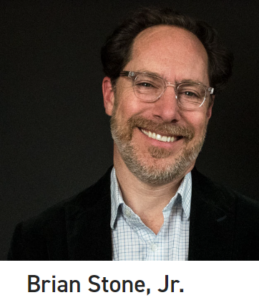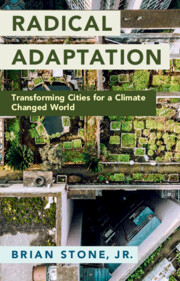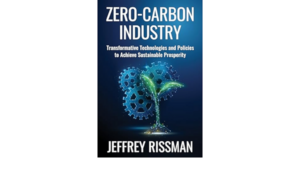Is your city ready for extreme heat, floods, and wind? No! It is time for “Radical Adaptation” with Professor Brian Stone, Director of the Urban Climate Lab at Georgia Tech. Can we still make cement, steel – the basics – without fossil fuels? Is fossil-free tech out there now? We catch up with Jeffrey Rissman, Senior Director, Industry at Energy Innovation.
Listen to or download this Radio Ecoshock show in CD Quality (57 MB) or Lo-Fi (14 MB)
BRIAN STONE:
RADICAL CLIMATE ADAPTATION FOR CITIES
Most of you live in cities. The majority of humans do. Is your city ready for climate disruption? You know it is not – and just planting more trees won’t cut if for what is coming.

For the past couple of decades, Dr. Brian Stone studied cities in a changing climate – from nighttime heat stress through grid failure during heat waves. His 2012 book “The City and the Coming Climate: Climate Change in the Places We Live” won awards. Professor Stone is Director of the Urban Climate Lab at Georgia Tech. Now, at this late date in the climate shift, he goes further. Stone’s latest book is “Radical Adaptation: Transforming Cities for a Climate Changed World”.
According to his bio “Jeff holds an M.S. in Environmental Sciences and Engineering and a Masters in City and Regional Planning, both from the University of North Carolina at Chapel Hill. He was a Research Fellow for the University of North Carolina Institute for the Environment, where he studied aircraft emissions for the Federal Aviation Administration.”
Listen to or download this interview with Brian Stone (30 min) in CD Quality or Lo-Fi
Brian studied the vulnerabilities of cities to increasing extreme heat. Last time we talked on Radio Ecoshock he warned there are not nearly enough cooling centers with generator backup for a grid failure in extreme heat.
Back in 2019 Stone suggested: “The UK is quietly becoming one of the deadliest places on Earth for heat waves.” How can that happen in that “green and pleasant land” and why “Heat Waves as Hurricanes”? See also this new article in the Guardian:UK heatwave plan urgently needed to save lives, say MPs Damian Carrington Jan. 31, 2024.
RETREAT FIRST
The U.S. Census Bureau says approximately 40% of the U.S. population lives within 100 miles of the East or West coasts. In fact, the United Nations says about 40% of the world’s population lives within 100 kilometers of the coast, or 62 miles. Humans thrive near oceans. Major cities with millions of people live where rising seas and storm surge can rush in. Can we count on building defenses, is that happening, or will it be retreat from the sea?

In fact, Stone’s book on Radical Adaptation says retreat is not the last step, but the first. It is our chance to get people – often the poorest people are most exposed – away from floodable places and into sustainable housing. Retreat is a chance for redesign – and when it comes to sea level rise accompanied by storm surges, there are not enough bags of sand of cement on the planet to prevent retreat from becoming the only real option. We can stall but then we leave. It’s better to do it by design rather than by catastrophe.
Most North American cities and suburbs were built around the car. We have houses in cul-de-sacs with nothing in walking distance and no public transportation. An article in Newsweek January 15, 2024 says “Americans Can No Longer Afford Their Cars”. New cars cost what a house did, used care prices are insane, insurance is high. More and more working people can’t afford a car and can’t make a living without one. Are people going to walk away from all those homes during a housing shortage? Will we abandon the suburbs or adapt?
I wonder if cities can change. Back in 2009 I broadcast from a Resilient Cities Conference in Vancouver. The Ecocity World Summit was in Montreal in 2010. Then we have Transition Towns. That movement seems quieter though continuing. Most cities seem frozen in the past. What will it take to finally bring on Radical Adaptation? Perhaps even the Transition Town vision was not radical enough for the challenges we now face?
As the Viennese climate scientist Richard Steurer warns, there are so many crisis and worries these days, from wars to growing homelessness. It is hard to focus and plan for this climate future. I fear cities will just get repeatedly wrecked by extreme weather until they can’t cope. How about you?
Our conversation with Brian Stone reminds me of an interview with the Greek academic then working in Australia, Dr. Mat Santamouris. He led a project called “Zero-Plus“- “Achieving near Zero and Positive Energy Settlements in Europe”. It was funded by the European Union and four “zero-plus” settlements are under construction. Santamouris has detailed suggestions to lower urban heat and make cities more enjoyable to live in during warming.
In 2018, University of Cumbria sustainability professor Jem Bendell published his paper “Deep Adaptation: A Map for Navigating Climate Tragedy“. He concluded nothing about this civilization is sustainable and societal collapse was inevitable. I don’t think we can count on collapse.
When threatened by new situations, humans, and maybe Americans in particular, often retreat toward their vision of the past. They may literally fight to keep their fossil-powered lifestyles and expectations of plenty. Even folks who lost their homes during storms or fires try to rebuild the same fragile system. There is a growing consensus the real threat is less climate change and more inability to achieve human change. But Stone is optimistic research and books can help.
Stone’s latest book is “Radical Adaptation: Transforming Cities for a Climate Changed World”. Your can read a summary article about Brian Stone’s work for city futures here at Medium: “Radical Adaptation: Unlearning How to Plan a City”.
QUOTES FROM BRIAN’S SUMMARY ARTICLE IN MEDIUM
“In the coming summers, US cities will experience for the first time a combination of heat and humidity too deadly to enable basic municipal services, such as trash collection, to be safely carried out. The garbage trucks themselves will be of no use in hauling away the heat; we cannot divert it to our storm sewer systems for transport to centralized treatment facilities. In a climate changed world, it is no longer sufficient to collect and treat our urban environmental effluent — stormwater, excessive heat, planet warming emissions — we must lessen the volume of effluent to be managed.
In my recently published book, Radical Adaptation: Transforming Cities for a Climate Changed World, I propose four fundamental changes to the ways in which we manage environmental hazards in cities. In place of large centralized public works facilities, infrastructure for radical adaptation must be integrated into every parcel and neighborhood. Rather than directing public resources to the areas of greatest potential physical impact, a radical approach to climate adaptation is directed to the zones of greatest human vulnerability. Novel strategies once perceived as socially untenable will need to be embraced. And last, under a radical framework, planned retreat within cities is not the last step in a series of adaptative actions but the first. In each instance, a radical approach to climate adaptation is not a scaling up of conventional management systems but an almost complete inversion of strategies developed during the now concluded era of climate stability. We must, in short, unlearn how to plan our cities and plan them anew.”
You may also be interested in these two previous Stone papers from 2021 – “Persistent increases in nighttime heat stress from urban expansion despite heat island mitigation” and “Compound climate and infrastructure events: how electrical grid failure alters heat wave risk”.
========================================
JEFFREY RISSMAN
Can There Be Industry Without Fossil Fuels?
In the hottest times of human history, the panic ask: can we have industrial civilization AND a livable climate? Can we make things like steel, cement and chemicals without adding greenhouse gases? The products you buy and the way you live depend on getting the right answers.

With two Masters degrees in the environment, engineering and planning, Jeffrey Rissman is Senior Director for Industry at the American non-profit Energy Innovation. Following earlier books and guides, Rissman lays out future-viable technologies in his upcoming book “Zero-Carbon Industry: Transformative Technologies and Policies to Achieve Sustainable Prosperity”. This is a huge new book published by Columbia University Press. It covers almost every pathway to net-zero production. We couldn’t cover it all in 20 interviews, so we focus on a couple of basics our listeners use every day: steel and cement.
Listen to or download this interview with Jeffrey Rissman in CD Quality or Lo-Fi
FOSSIL-FREE STEEL?
We start with a headline familiar to all our UK listeners: the Indian-owned conglomerate Tata is closing down a coal-fired conventional steel mill in the south of Wales. Port Talbot has been a mill town for generations and now 3,000 decently paid workers lose their jobs. The UK Conservative government is funding a change from coal power to electric arc furnaces, with half a billion Pounds of taxpayer money for the four-year conversion. It will cut UK’s overall emissions by around 1.5 percent. I ask Jeff Rissman to put this news into the larger story of trying for steel production without fossil fuels.

The electric arc furnaces could be mainly powered by renewable energy, but so far still need natural gas heating for part of the process. There are alternatives and innovations in Sweden and Germany could make steel production possible in a net-zero emissions world.
There is a lot of breaking news on carbon-free steel: “An electrifying new ironmaking method could slash carbon emissions – By extracting metallic iron without producing carbon dioxide, the new process could even be carbon negative, at least for part of the world’s iron production” 5 Feb 2024.
SEE ALSO: The Race Is On to Make Low-Emissions Steel. Meet One of the Companies Vying for the Lead InsideClimateNews Dec 2023]
The Race Is On to Make Low-Emissions Steel. Meet One of the Companies Vying for the Lead.
Because steel is put into long-lasting sequestration like buildings and not ready for recycling, and today’s demand is much higher than when older steel was made, the amount of reusable steel is always going to be less than demand – unless there is a major collapse in demand (a scenario not investigated in this Rissman book.)
Perhaps steel-making has to follow the aluminum industry to build plants near large renewable resources (e.g. Kitimat aluminum in B.C. powered by hydro electricity; or plants in Iceland powered by combined hyrdo and geothermal energy.) Maybe Tata should move it’s new steel plant to Iceland? Would those greenhouse gas savings be lost in longer shipping routes to manufacturing? Rissman says the large carbon savings of putting plants near green energy would outweigh smaller shipping emissions.
The barriers are cost and time, economic drivers and social will. Converting an industrial system so heavily dependent on fossil fuels is a slow process. Even the most progressive companies are aiming for 2045 at the earliest. What if that is just too slow and too late for the realities of the climate system with unstoppable tipping points?
GETTING CONCRETE = 7% of global CO2 emissions!
The new book ““Zero-Carbon Industry: Transformative Technologies” next tackles “the most-used human-made material”. Concrete has become a mania with humans. Cement makers are a significant contributor to the rise in greenhouse gases. Rissman says in the book “Cement-making represents roughly 7 percent of global CO2 emissions.” That is huge!
But then strangely – and I did not know this – aging cement begins to absorb carbon dioxide from the air, become helpful to slow climate change. Is cement carbon absorption significant, and is it enough to compensate for all the emissions making concrete? No – because the amount of cement available for slow absorption is overshadowed by the need for more cement production. As Rissman writes in the book:
“Over a period of decades, the cement absorbs CO2 equivalent to almost half of the process emissions (i.e., excluding energy-related emissions) released when the cement was made. Cement carbonation is significant on a global scale. For instance, in 2013, carbonating cement removed 0.9 billion metric tons of CO2 from the atmosphere, offsetting 2–3 percent of that year’s global CO2 emissions.”
Again, green avenues are being explored, as Rissman explains.
Check this out: WHERE CEMENT IS MADE (from the book)
“In 2019, 4.1 billion metric tons of cement were produced worldwide. Production was essentially flat from 2014to 2019, after having grown at an average rate of 6.4 percent per year from 2000 to 2014. China produces 55 percent of the world’s cement, while India is second, with 7.5 percent. No other country is responsible for more than roughly 2 percent.
Cement production is projected to rise to 4.6 billion metric tons per year by 2050, with production in India and Africa more than tripling (and non-China, non-India Asia more than doubling), more than compensating for anticipated declines in Chinese output.”
The final section of this book lays out a series of tools the governments can implement to pressure industry into net-zero production. Most of the methods have been known for years but still our emissions keep rising. I think that is because the vast profits of fossil fuels have captured not just regulatory agencies but complete governments in many countries. They don’t want to hurt the golden goose. So the barriers are really social, cultural, and perhaps psychological – instead of technical. Yet we need new technology to keep anything running, so Rissman is covering important work less visible to the public: ways industry can produce fossil-free.
You can also watch this YouTube video With Jeff Rissman. It shows contents of book and presents an overview: “A Sectoral Approach to Climate Mitigation: The Industrial Sector.”
One thing I like about this book: every step of the way Rissman teaches us how things are made, what the carbon costs of materials are, how the world around us is built. But I don’t see enough about low-impact living, making products built to last, slashing waste, reducing animal agriculture or anything about fairness and equity. This is strictly technology for the times we live in now, with no big social changes assumed. But willy-nilly there will be big social changes…
Rissman is optimistic. He is not approaching climate as doom, but as a challenge which will end up making us better. He does cover coincident parasitic behavior like Patent Infringement scams, but not much about corporate misbehavior or the invasion of criminal or hostile national agents into this industrial transition. So much relies on the goodwill effort of humans. There is some of that, but enough?
The book doesn’t deal with the impacts of actual on-going climate change, a pandemic, and rapid impact of AI on jobs. The world of political division, heavily funded robot-assisted disinformation, negativity of algorithms for clicks and on-going corporate misinformation. For example, new science shows the Canadian Tar Sands wildly under-reported – thousands of times lower than reality measured by scientists. And we base our emissions policy on that? But who can cover all that in one book? The work is already big and dense working the industrial transition angle.
Rissman reminds me of Mark Jacobson of Stanford and his plans to power the world with renewables. Jacobson says we can, explains how – but will we? Are “we” organized and truthful enough, kind enough, as humans to save ourselves?
Hear Mark Jacobson on this Radio Ecoshock show (2014)
========================================
ALEX UPDATE: U.S. BECOMES WORLD’S BIGGEST OIL DEALER
Last week on Radio Ecoshock we discovered even more climate-wrecking emissions as methane, so-call natural gas burning hits absolute record highs. U.S. fracking production is overflowing into multiple giant Liquified Natural gas ports in Canada, the United States and Mexico. Their plans and investments stretch decades into our damaged future.
Then I warned “Don’t forget about oil”. Everything runs on oil and oil bi-products from transportation through trillions of tons of plastics, cosmetics, clothes, everything. According to the International Energy Agency total world demand rose 2.3 million barrels a day – every single day. They project global demand for oil by 2050 to be a third higher than that.
Who are the oil giants poisoning the atmosphere? You want to say Saudi Arabia, but they are only the third largest oil producer and exporter. Russia is number two. America is the single largest producer of oil, the pollution from burning it, the left-over toxins, and the end of the climate we evolved in. America is number one.
The boost in U.S. oil production is strange. We used to gauge it by the number of active rigs drilling for oil. The rig count went down significantly in 2023 and down 69% since 2014., but American oil production went up to a new monthly record of 13.3 million barrels a day. According to John Kemp at Reuters, February 1st, 2024, quote: “Exploration and production firms have continued to increase output despite drilling fewer wells, by concentrating on the best sites, accelerating drilling times and boring longer horizontal sections for each well.”
The Reuters business article finds “plenty of economic benefits” as America becomes the world’s largest oil exporter. No mention of climate.
This oil and gas energy boom sounds great for everyone! I hope this year’s heat and wild weather swings doesn’t kill off my fruit trees. With hardly any snow this mild winter, we expect a dry hot summer and maybe another record year for wildfires in the West. I hope our house doesn’t burn down. I hope the bees and the bugs can make it for another year. I hope humans come to their senses and end this fossil-fuels-to-the-bitter-end party.
I’m Alex. Thank you for listening and caring about our world.
Help independent radio journalism stay on the air. Keep Radio Ecoshock free for everyone around the world and advertising free. Please add you financial support if you can.